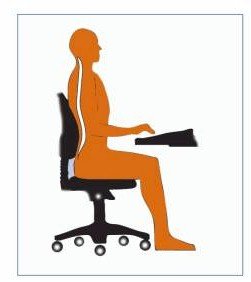 Today’s modern office requires most of us to spend most of our time sitting down in front of our computers, totally conflicting with the natural state in which the body is supposed to be. Sitting down for hours at an end is a leading cause of office work-related injuries. This is why it is important to observe ergonomics, and to incorporate the use of ergonomic office furniture.
Today’s modern office requires most of us to spend most of our time sitting down in front of our computers, totally conflicting with the natural state in which the body is supposed to be. Sitting down for hours at an end is a leading cause of office work-related injuries. This is why it is important to observe ergonomics, and to incorporate the use of ergonomic office furniture.
What Does Ergonomics Mean?
Ergonomics is the application of scientific and technological principles where objects and systems are designed to be of optimum use to the human body, thereby lessening or even preventing the occurrence of pain and injury to the body in the continuous use of these objects and systems. In the workplace, ergonomics is best observed in the use of ergonomic office furniture, which can minimize injuries to the user’s body in the course of a days work.
To create an ergonomic work space, we should take into consideration four elements: the angle of the computer monitor, the lighting of the work space, the position of the keyboard and mouse, and the supports on the chair being used.
The Computer Monitor
When you position your computer monitor on your desk, you have to take note of the fact that you would be required to stare at it for long periods of time, sometimes for hours at end. So, you would need to protect your eyes from the glare that can result when the light reflects on your computer monitor.
The ergonomic way of doing it is to place your computer monitor as far away from you as possible, when you are sitting at your desk, without hampering your capacity to read whatever is on your monitor. Ideally, your monitor should be around 20 inches away from you, perhaps more.
To minimize eyestrain, the angle of your head should be at a 15-degree down angle from the center of the screen. Also, your neck should be bent in such a way that your head is at a perpendicular angle to the floor.
The Lighting
Proper lighting is essential in creating an ergonomic workspace. Too much light can create glare, and glare can hurt the eyes. The lighting in an ergonomic workspace should only be moderately bright. What we mean by this is that the brightness of the light inside the room should be just like what it would be outdoors on a clear day.
Also, the lighting in a room should be at a right angle with the monitor in order to reduce the glare to the eyes. It would also help to mix fluorescent lights with incandescent lights to provide a warm color of light that is easy on the eyes.
The Keyboard and the Position Of The Mouse
How you hold your wrists and arms as you type on your keyboard, and how you click on your mouse is a significant factor in preventing injuries to your wrist, including the occurrence of carpal tunnel syndrome. If you are to follow the principles of ergonomics, you should keep your keyboard and mouse aligned to the angle of your monitor, at a negative angle away from you so that your wrists will remain straight as you hold them over your keyboard.
To accomplish this, use a desk with an adjustable tray for your keyboard and mouse. The tray should be angled so that the keyboard is tilted away from you. Never place your keyboard on the top of your desk; if you do this, you will strain your wrists by holding them at an angle towards your body. Also, you can ignore the keyboard support at the back of your keyboard. Using them is actually contrary to the principles of ergonomics, as they tilt the keyboard towards you, rather than away from you. In addition to that, your mouse should be kept at the same level as your keyboard.
Moreover, when you are typing, lift your wrists instead of letting them rest on your wrist rest. Use these wrist rests only when you are not typing.
The Ergonomic Chair
Your chair is probably the most important element that you should consider when you are creating your ergonomic office space. The chair you should get for yourself should be ergonomically designed. An ergonomic chair will provide support for your arms, back, shoulders and neck as you spend your hours in front of your computer.
Your ergonomic chair should be something that is adjustable so that its height will allow your feet to rest flat on the floor. The curve of the back of your ergonomic chair should also fit the curve of your back. The edge of the seat should be at least one inch away from the back of your knees. The seat of your ergonomic chair should also be wide enough to fit your hips and thighs without being squeezed or pinched in. An ergonomic chair with a high back is also desirable to provide support for your shoulders and neck.
Following the principles of ergonomics and using ergonomic office furniture in your workspace, will help a lot in minimizing workplace injuries to your body. Be kind to your body and set your workplace up with ergonomic office furniture!